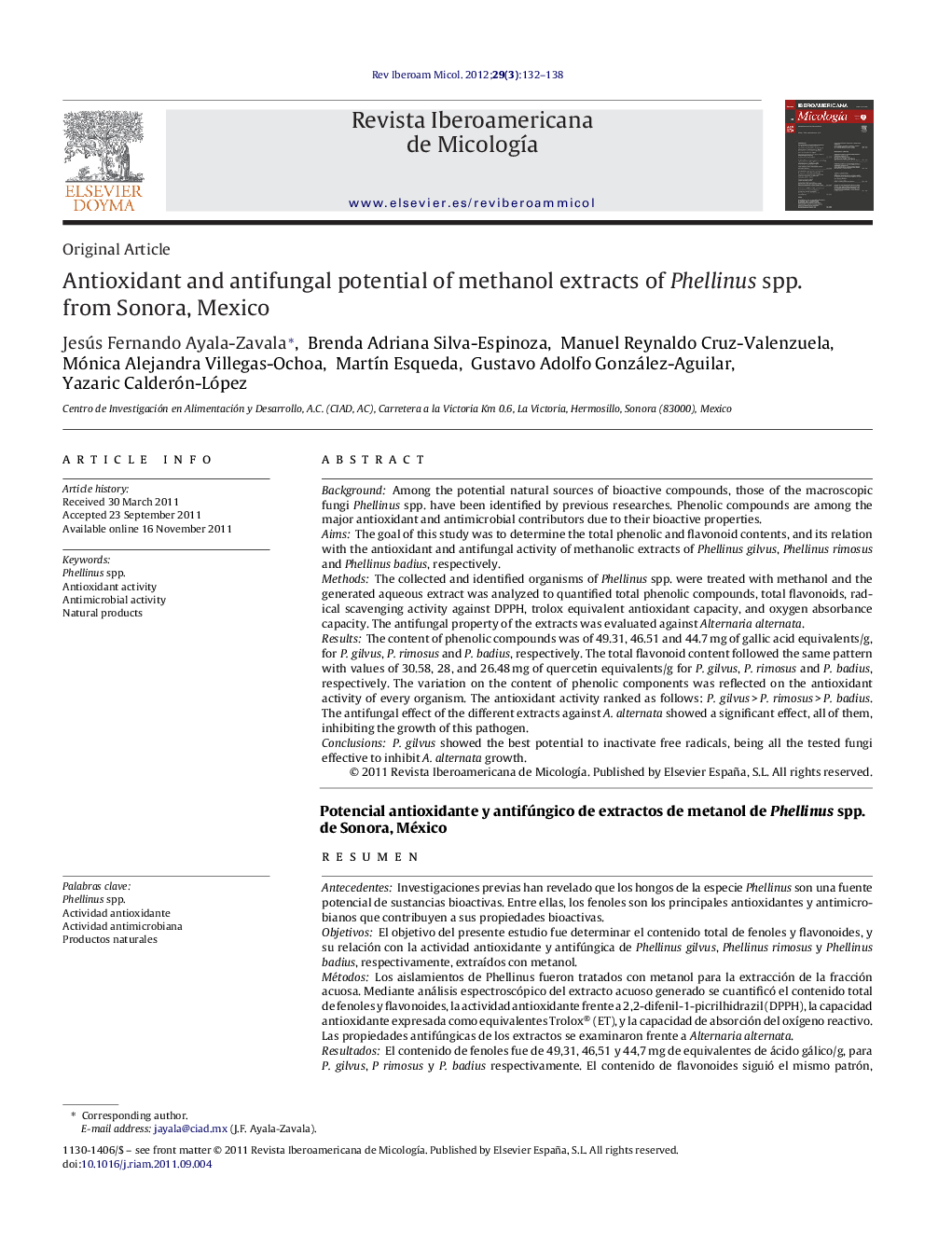| کد مقاله | کد نشریه | سال انتشار | مقاله انگلیسی | نسخه تمام متن |
|---|---|---|---|---|
| 3418981 | 1225792 | 2012 | 7 صفحه PDF | دانلود رایگان |

BackgroundAmong the potential natural sources of bioactive compounds, those of the macroscopic fungi Phellinus spp. have been identified by previous researches. Phenolic compounds are among the major antioxidant and antimicrobial contributors due to their bioactive properties.AimsThe goal of this study was to determine the total phenolic and flavonoid contents, and its relation with the antioxidant and antifungal activity of methanolic extracts of Phellinus gilvus, Phellinus rimosus and Phellinus badius, respectively.MethodsThe collected and identified organisms of Phellinus spp. were treated with methanol and the generated aqueous extract was analyzed to quantified total phenolic compounds, total flavonoids, radical scavenging activity against DPPH, trolox equivalent antioxidant capacity, and oxygen absorbance capacity. The antifungal property of the extracts was evaluated against Alternaria alternata.ResultsThe content of phenolic compounds was of 49.31, 46.51 and 44.7 mg of gallic acid equivalents/g, for P. gilvus, P. rimosus and P. badius, respectively. The total flavonoid content followed the same pattern with values of 30.58, 28, and 26.48 mg of quercetin equivalents/g for P. gilvus, P. rimosus and P. badius, respectively. The variation on the content of phenolic components was reflected on the antioxidant activity of every organism. The antioxidant activity ranked as follows: P. gilvus > P. rimosus > P. badius. The antifungal effect of the different extracts against A. alternata showed a significant effect, all of them, inhibiting the growth of this pathogen.ConclusionsP. gilvus showed the best potential to inactivate free radicals, being all the tested fungi effective to inhibit A. alternata growth.
ResumenAntecedentesInvestigaciones previas han revelado que los hongos de la especie Phellinus son una fuente potencial de sustancias bioactivas. Entre ellas, los fenoles son los principales antioxidantes y antimicrobianos que contribuyen a sus propiedades bioactivas.ObjetivosEl objetivo del presente estudio fue determinar el contenido total de fenoles y flavonoides, y su relación con la actividad antioxidante y antifúngica de Phellinus gilvus, Phellinus rimosus y Phellinus badius, respectivamente, extraídos con metanol.MétodosLos aislamientos de Phellinus fueron tratados con metanol para la extracción de la fracción acuosa. Mediante análisis espectroscópico del extracto acuoso generado se cuantificó el contenido total de fenoles y flavonoides, la actividad antioxidante frente a 2,2-difenil-1-picrilhidrazil (DPPH), la capacidad antioxidante expresada como equivalentes Trolox® (ET), y la capacidad de absorción del oxígeno reactivo. Las propiedades antifúngicas de los extractos se examinaron frente a Alternaria alternata.ResultadosEl contenido de fenoles fue de 49,31, 46,51 y 44,7 mg de equivalentes de ácido gálico/g, para P. gilvus, P rimosus y P. badius respectivamente. El contenido de flavonoides siguió el mismo patrón, con valores de 30,58, 28 y 26,48 mg de equivalentes de quercetina/g, para P. gilvus, P. rimosus y P. badius, respectivamente. La variación en el contenido de fenoles se reflejó en la actividad antioxidante de cada hongo. La actividad antioxidante se clasificó del modo siguiente: P. gilvus > P. rimosus > P. badius. El efecto antifúngico de los diferentes extractos frente a A. alternata fue significativo, inhibiendo todos ellos el crecimiento de dicho patógeno.ConclusionesP. gilvus manifestó la mayor capacidad antioxidante y los extractos de los tres hongos inhibieron el crecimiento de A. alternata.
Journal: Revista Iberoamericana de Micología - Volume 29, Issue 3, July–September 2012, Pages 132–138